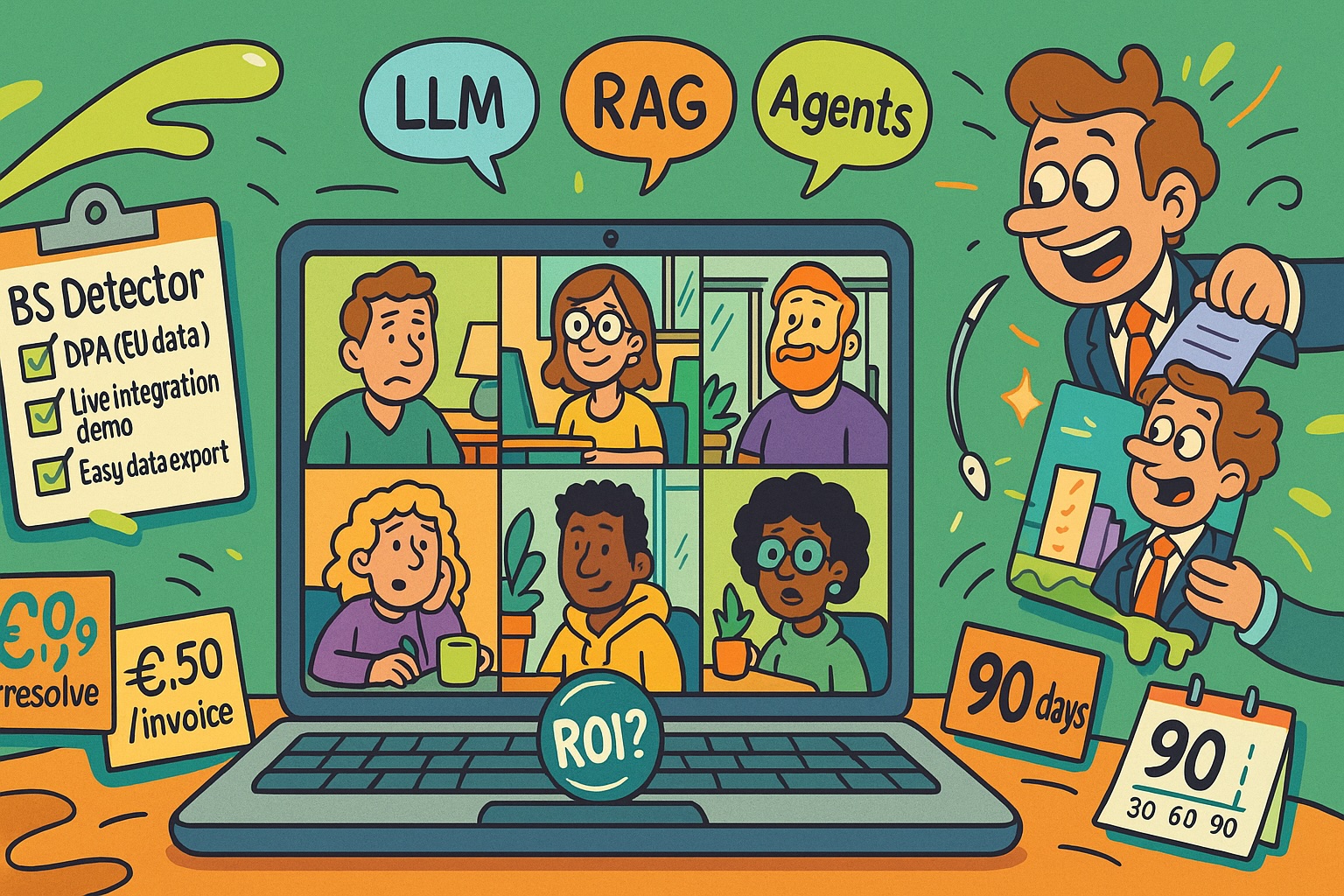
Worried you'll spend €100k on AI and get nothing but a fancy dashboard and a headache? You're not alone. Most AI projects fail not due to the technology itself, but because buyers ask the wrong questions and get dazzled by jargon instead of results.
Let's fix that.
I've sat in the same meetings you have. I've seen the slick presentations from vendors promising to "revolutionize your paradigm" with AI. They throw around terms like "LLM," "RAG," and "agentic workflows," hoping you'll nod along and sign the cheque. It's a strategy designed to make you feel like you're behind the curve.
You're not. You're an expert in your business, and that's the only expertise you need to make a wise decision.
We're going to cut through the noise with a simple, business-first framework.
Before you look at a single vendor, you need to answer one question: What expensive, annoying, or time-consuming problem are you trying to solve?
Buying an AI tool without a clear problem in mind is like walking into a hardware store and purchasing a saw. Is it a good saw? Maybe. But if you needed to drill a hole, you just wasted your money.
Don't let a vendor tell you what your problems are. You tell them.
Get specific. Is it:
Please write it down. Put a number on it—the time it takes, the money it costs, the revenue you're losing. That number is your north star. Any vendor who can't speak directly to solving that specific problem doesn't deserve your time.
Once you have your problem defined, you can start talking to vendors. But you need a few non-negotiable rules to separate the serious partners from the pretenders quickly.
If a vendor fails any of these three tests, the conversation is over.
For any business in the EU or UK, this is ground zero. Ask them: "Will you sign our Data Processing Agreement (DPA) and guarantee our data stays within the EU?"
If they hesitate, hedge, or say "our standard agreement should cover it," walk away.
A DPA isn't a nice-to-have; it's a legal requirement under GDPR that dictates how they handle your data. No signed DPA, no deal. Period.
Your business probably runs on a few key platforms, like Microsoft 365, HubSpot, Salesforce, or Slack. Your new AI tool must play nice with them.
Don't accept a screenshot or a promise on a slide.
Say this: "Show me a live, end-to-end demo of your tool working with our systems, using a sample of our anonymized data."
If they can't do that within a week or two, their "seamless integration" is probably just vapourware. You're not buying a standalone toy; you're purchasing a capability that has to fit into your existing workflows.
This one is simple. Ask: "How do we get our data out if we decide to leave?"
The silence you might get is your answer.
A trustworthy partner will have a transparent, documented process for exporting your data. A vendor who wants to lock you in will make the terms vague and complex to understand. You must be able to get your data back, in a usable format, without paying a king's ransom for it.
(Yes, really.)
Every vendor will tell you their solution delivers excellent ROI. Your job is to ignore the adjectives and demand the evidence.
Don't let them show you a case study from a 10,000-person global bank if you're a 150-person manufacturing firm. It's irrelevant.
Ask for this specifically: "Can you connect me with 2-3 of your customers who are our size, in our industry, and our region?"
You want to talk to people who have faced your exact challenges and see if this vendor truly delivered. If their only references are massive US-based companies, they might not understand the realities of your business or compliance needs.
Before you sign a pilot agreement, you and the vendor must agree on the definition of success.
It should be something like:
If a vendor can't or won't commit to a measurable outcome, it's because they aren't confident they can achieve it. Put the success criteria right into the pilot agreement.
Traditional SaaS pricing—paying per user, per month—is often a terrible model for AI. Why should you pay more just because another person on your team logs in?
It makes no sense.
Stop paying for seats. Start paying for outcomes.
Look for vendors with pricing based on the value you receive. For example:
This model aligns the vendor's success with your success. They only make more money if they are delivering more value. It's transparent, predictable, and fair. Expect to budget between €50,000 and €250,000 annually for a real solution, but make sure that the cost is tied to real work being done.
You don't need a year to figure out if an AI tool is working. You need 90 days. A paid pilot is the best way to test a solution with minimal risk.
Here's the plan:
Feeling a little more confident? Good.
This isn't about becoming a data scientist overnight. It's about being an expert in your own business and asking thoughtful, direct questions. You have the power to control the conversation and demand answers that matter.
You're not buying AI. You're buying a business outcome.
If you're evaluating a vendor, want a second opinion, or need help defining the problem you want to solve, let's talk. We can help you distinguish between true partners and pretenders.
More insights from the ai-software category
Get the latest articles on AI automation, industry trends, and practical implementation strategies delivered to your inbox.
Discover how Xomatic's custom AI solutions can help your organization achieve similar results. Our team of experts is ready to help you implement the automation strategies discussed in this article.
Schedule a Consultation